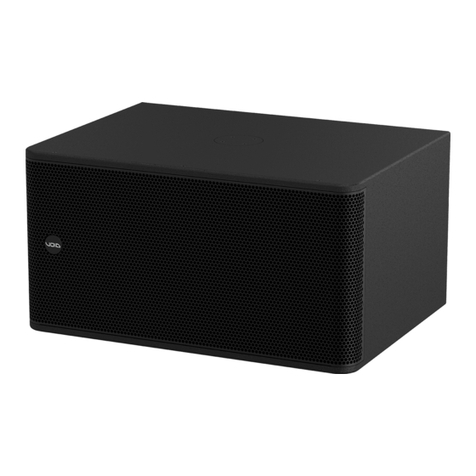Void STASYS 4 User manual

Stasys 4
User Guide V1.0

©2018 Void Acoustics Research Ltd.
Version 1.0
This user guide is subject to change without notice.
For the latest online version, visit: www.voidacoustics.com
Void Acoustics and the Void logo are registered trademarks of Void
Acoustics Research Ltd. in the United Kingdom, USA and other
countries; all other Void trademarks are the property of Void Acoustics
Research Ltd.

Stasys 4 User Guide V1.0
Page 3
Contents
1 Safety and regulations 4
1.1 Important safety instructions 4
1.2 Limitations 4
1.3 EC declaration of conformity 4
1.4 WEEE directive 4
2 Limited warranty 5
3 Unpacking and Checking 6
4 Introduction 7
4.1 Welcome 7
4.2 Stasys 4 overview 7
4.3 Key features 7
4.4 Stasys 4 specifications 8
4.5 Stasys 4 dimensions 9
5 Cabling and wiring 10
5.1 Electrical Safety 10
5.2 Cable considerations for fixed installations 10
5.3 Active/Passive mode switch 10
5.4 Stasys 4 wiring diagram 11
5.5 Bias V3/V9 speakONTM wiring passive mode 12
5.6 Bias VQ speakONTM wiring passive mode 12
5.7 Bias D1/Q2 Phoenix/speakONTM wiring passive mode 13
5.8 Bias Q5 speakONTM wiring passive mode 13
5.9 Bias V3/V9 speakONTM wiring active mode 14
5.10 Bias VQ speakONTM wiring active mode 14
5.11 Bias D1/Q2 Phoenix/speakONTM wiring active mode 15
5.12 Bias Q5 speakONTM wiring active mode 15
6 System design 16
6.1 System design principles 16
6.2 Loudspeaker placement and positioning 17
7 Mounting 20
7.1 Installation safety 20
7.2 Pole mounting 21
8 Service 22
8.1 Return Authorisation 22
8.2 Shipping and packing consideration 22
9 Appendix: Architectural specification 23

Stasys 4 User Guide V1.0
Page 4
1.1 Important safety instructions
The lightning flash with and arrowhead symbol
within an equilateral triangle is intended to alert the
user to the presence of uninsulated “dangerous
voltage” within the product’s enclosure that may
be of sucient magnitude to constitute a risk of
electric shock to persons.
The exclamation point within an equilateral triangle
is intended to alert the user of the presence of
important operating and maintenance (servicing)
instructions in the literature accompanying the
appliance.
Safety instructions - read this first
1. Read these instructions.
2. Keep these instructions.
3. Heed all warnings.
4. Follow all instructions.
5. Do not use this apparatus near water.
6. Clean only with a dry cloth.
7. Do not block any ventilation openings. Install in accordance
with the manufacturer’s instructions.
8. Do not install near any heat source such as radiators, heat
registers, stoves, or other such apparatus that produce heat.
9. Do not defeat the safety purpose of the grounding-type
plug. A grounding type plug has two blades and a third
grounding prong. The third prong is provided for your safety.
If the provided plug does not fit into your outlet, consult an
electrician for replacement of the obsolete outlet.
10. Protect power cords from being walked on or pinched
particularly at plugs, convenience receptacles, and the point
where they exit the apparatus.
11. Onlyuseattachmentsandaccessoriesspecifiedby Void
Acoustics.
12. Only use with the cart, stand, tripod, bracket, or table specified
by the manufacturer, or sold with the apparatus. When a
cart is used, use caution when moving the cart/apparatus
combination to avoid injury from tip-over.
13. Unplugtheapparatusduringlightningstormsorwhenunused
forlongperiodsoftime.
14. Refer all servicing to qualified service personnel. Servicing
is required when the apparatus has been damaged in
any way, such as when the power-supply cord or plug is
damaged, liquid has been spilled or objects have fallen into
the apparatus, the apparatus has been exposed to rain or
moisture, does not operate normally, or has been dropped.
15. Since the mains power supply cord attachment plug is used
to disconnect the device, the plug should always be easily
accessible.
16. Void loudspeakers can produce sound levels capable
of causing permanent hearing damage from prolonged
exposure. The higher the sound level, the less exposure
needed to cause such damage. Avoid prolonged exposure to
the high sound levels from the loudspeaker.
1.2 Limitations
This guide is provided to help familiarise the user with the
loudspeaker system and its accessories. It is not intended to provide
comprehensive electrical, fire, mechanical and noise training and is
not a substitute for industry-approved training. Nor does this guide
absolve the user of their obligation to comply with all relevant
safety legislation and codes of practice.
While every care has been taken in creating this guide, safety is
user-dependent and Void Acoustics Research Ltd cannot guarantee
complete safety whenever the system is rigged and operated.
1.3 EC declaration of conformity
Manufacturer:
Void Acoustics Research Ltd,
Unit 15 Dawkins Road Ind Est,
Poole, Dorset,
BH15 4JY,
United Kingdom.
We declare the under our sole responsibility the following product
models: Stasys 2, 3, 4, 5, 8, X, Xv2, Xair, 218, 118, Prime
are intended to be used as loudspeakers and are in conformity with
the following EC Directives, including all amendments, and with
national legislation implementing these directives:
• BS EN 60065:2002
• BS EN 55103-1/-2
March 2016
Alex Skan
Technical Director
1.4 WEEE directive
If the time arises to throw away your product, please recycle all the
components possible.
This symbol indicates that when the end-user
wishes to discard this product, it must be sent
to separate collection facilities for recovery
and recycling. By separating this product from
other household-type waste, the volume of
waste sent to incinerators or land-fills will be
reduced and natural resources will thus be
conserved.
The Waste Electrical and Electronic Equipment Directive (WEEE
Directive) aims to minimise the impact of electrical and electronic
goods on the environment. Void Acoustics Research Ltd complies
with the Directive 2002/96/EC and 2003/108/EC of the European
Parliament on waste electrical finance the cost of treatment and
recovery of electronic equipment (WEEE) in order to reduce the
amount of WEEE that is being disposed of in land-fill sites. All of
our products are marked with the WEEE symbol; this indicates that
this product must NOT be disposed of with other waste. Instead
it is the user’s responsibility to dispose of their waste electrical
and electronic equipment by handing it over to an approved
reprocessor, or by returning it to Void Acoustics Research Ltd for
reprocessing. For more information about where you can send
your waste equipment for recycling, please contact Void Acoustics
Research Ltd or one of your local distributors.
1 Safety and regulations

Stasys 4 User Guide V1.0
Page 5
Limited warranty
The warranty
For a period of three (3) years from the date of
delivery to the original purchaser (as shown on the
original invoice or sales receipt; a copy of this may be
required as proof of warranty dates), Void Acoustics
Research Ltd (hereinafter ‘Void’) warrants to the
Original Owner (person or company who originally
purchased the product brand new from either Void
or a Void Authorised Dealer/Distributor) of each new
Stasys Series product (provided it was purchased at
an Authorised Void Dealer) that it is free of defects
in materials and workmanship and that each
product will meet or exceed all factory published
specifications for each respective model. Void agrees
to repair or replace (at its discretion) all defective
parts at no charge for labour or materials; subject to
following provisions:
Warranty violations
Void shall take no responsibility for repair or
replacement as specified under this warranty, if
the damaged product has been subject to misuse,
accident, neglect or failure to comply with normal
maintenance procedures; or if the serial number
has been defaced, altered or removed. Nor will Void
accept responsibility for, or resulting from, improper
alterations or unauthorised parts or repairs. This
warranty does not cover any damage to speakers
or any other consequential damage resulting from
breach of any written or implied warranty.
Void warranty provisions
Void will remedy any defect, regardless of the
reason for failure (except as excluded) by repair, or
replacement. Void will remedy the defect and ship
the product within a reasonable time after receipt of
the defective product at a Void Authorised Service Centre.
To obtain warranty service
If a Void product requires service, the Owner must
contact Void or an Authorised Void Service Centre to
receive an R.A.N. (Return Authorisation Number) and
instructions on how to return the product to the Void
Authorised Service Centre, or to Void.
Void (or its Authorised Service Centre) will initiate
corrective repairs upon receipt of the returned
product. Please save the original carton and all the
packing materials in case shipping is required. All
products being returned to the factory or service
centre for repairs must be shipped prepaid.
If the repairs made by Void or the Void Authorised
Service Centre are not satisfactory, the Owner
is instructed to give written notice to Void. If the
defect or malfunction remains after a reasonable
number of attempts by Void to remedy the defect
or malfunction, the Original Owner shall then have
the option to elect either a refund or replacement of
said Void product free of charge. The refund shall be
an amount equal to but not greater than the actual
purchase price, not including any taxes, interest,
insurance, closing costs and other finance charges
(minus reasonable depreciation on the product).
If a refund is necessary, the Original Owner must
make the defective or malfunctioning product
available to Void free and clear of all liens or other
restrictions.
Equipment modifications
Technical and design specifications are subject to
change without notice.
Void reserves the right to modify or change
equipment (in whole or part) at any time prior to
delivery thereof, in order to include therein electrical
or mechanical improvements deemed appropriate
by Void, but without incurring any liability to modify
or change any equipment previously delivered, or
to supply new equipment in accordance with any
earlier specifications.
Disclaimer of consequential and incidental
damages
You, the Original Owner, are not entitled to recover
from Void any incidental damages resulting from any
defect in the Void product.
This includes any damage to another product or
products resulting from such a defect.
Warranty alterations
No person has the authority to enlarge, amend, or
modify this Warranty. This Warranty is not extended
by the length of time which the Original Owner
is deprived of the use of product. Repairs and
replacement parts provided pursuant to the Warranty
shall carry only the non-expired portion of the
Warranty.
This Statement of Warranty supersedes all
others contained in this user guide.
2 Limited warranty

Stasys 4 User Guide V1.0
Page 6
All Void Acoustics products are carefully manufactured and thoroughly tested before being
despatched. Your dealer will ensure that your Void products are in pristine condition before
being forwarded to you but mistakes and accidents can happen.
Before signing for your delivery:
• Inspect your shipment for any signs of contamination, abuse or transit damage as soon as
you receive it
• Check your Void Acoustics delivery fully against your order
• If your shipment is incomplete or any of its contents are found to be damaged; inform the
shipping company and inform your dealer.
When you are removing your Stasys 4 loudspeaker from its original packaging:
• Stasys 4 loudspeakers come double boxed and are stapled shut; take care when unboxing
and removing the staples to avoid injury or damage to the loudspeaker
• If you need to place the Stasys 4 loudspeaker on a flat surface ensure you use a lint free
product to protect the finish
• When you have removed the Stasys 4 loudspeaker from the packaging inspect it to ensure
there is no damage and keep all original packaging in case it needs to be returned for any
reason.
See section 2 for warranty conditions and see section 8 if your product needs servicing.
3 Unpacking and checking

Stasys 4 User Guide V1.0
Page 7
4.1 Welcome
Many thanks for purchasing this Void Acoustics Stasys 4. We truly appreciate your support.
At Void, we design, manufacture and distribute advanced professional audio systems
for the installed and live sound market sectors. Like all Void products, our highly skilled
and experienced engineers have successfully combined pioneering technologies with
groundbreaking design aesthetics, to bring you superior sound quality and visual innovation. In
buying this product, you are now part of the Void family and we hope using it brings you years
of satisfaction. This guide will help you both use this product safely and ensure it performs to
its full capability.
4.2 Stasys 4 overview
The Stasys 4 provides better o-axis rejection and constant coverage within its dispersion
angle than conventional horn designs. This critical factor enables the creation of a
multipurpose loudspeaker that is equally at home as a high level stage monitor as it is in
smaller, front-of-house applications. The asymmetrical enclosure comes equipped with
multiple flying points and an integral pole mount socket to suit both portable and permanently
installed applications.
4.3 Key features:
• Floor monitor or front of house applications
• Switchable bi-amp or passive operation modes
• Rotatable 90°H x 50°V HF waveguide
• 15” low frequency driver
• 1 x 1.5” neodymium high frequency compression driver
• 18 mm birch plywood construction
• Powerdrive type 100 flyplate
4 About

Stasys 4 User Guide V1.0
Page 8
4.4 Stasys 4 specifications
Frequency response 55 Hz - 20 kHz ±3 dB
Eciency1LF: 99 dB 1W/1m, HF: 108 dB 1W/1m
Crossover points Passive 1.6 kHz, active 1.6 kHz - 1.9 kHz Butterworth 18/24 dB/oct
Nominal impedance 8 Ω
Power handling2LF: 600 W AES, HF: 100 W AES
Maximum output3128 dB cont, 131 dB peak
Driver configuration 1 x 15” LF, 1 x 1.5” neodymium HF compression driver
Dispersion 90°H x 50°V rotatable
Connectors 2 x 4-pole speakON™ NL4
Height 750 mm (29.5”)
Width 450 mm (17.7”)
Depth 430 mm (16.9”)
Weight 38 kg (83.6 lbs)
Enclosure 18 mm 13-laminate birch plywood
Rigging Powerdrive type 100 flyplate
12 x M8 inserts
Top hat
Finish Textured polyurethane
Grille Perforated steel with foam filter
1Measured in half space 2AES2 - 1984 compliant 3Calculated
4 About
Figure 4.1: Horizontal directivity isobars Figure 4.2: Vertical directivity isobars

Stasys 4 User Guide V1.0
Page 9
430 (16.9”)
194
(7.6”)
14
(0.6”)
450 (17.7”)
750 (29.5”)
450 (17.7”)
430 (16.9”)
430 (16.9”) 450 (17.7”)
81.5
(3.2”)
70
(2.8”)
126
(5”)
300 (11.8”)
64
(2.5”)
160
(6.3”)
160.5
(6.3”)
160.5
(6.3”)
11.5°
11.5°
37.25
(1.5”)
56.5
(2.2”)
750 (29.5”)
4.5 Stasys 4 dimensions
Figure 4.3: Dimensions
4 About

Stasys 4 User Guide V1.0
Page 10
5.1 Electrical safety
To avoid electrical hazards please note the following:
• Do not access the inside of any electrical equipment. Refer servicing to
Void-approved service agents.
5.2 Cable considerations for fixed installations
We recommend specifying installation-grade Low Smoke Zero Halogen (LSZH) cables for
permanent installations. The cables should use Oxygen Free Copper (OFC) of grade C11000
or above. Cables for permanent installations should be compliant with the following standards:
• IEC 60332.1 Fire retardancy of a single cable
• IEC 60332.3C Fire retardancy of bunched cables
• IEC 60754.1 Amount of Halogen Gas Emissions
• IEC 60754.2 Degree of acidity of released gases
• IEC 61034.2 Measurement of smoke density.
We suggest using the following maximum copper cable lengths to keep level losses below 0.6 dB.
Metric mm2Imperial AWG 8 Ωload 4 Ωload 2 Ωload
2.50 mm213 AWG 36 m 18 m 9 m
4.00 mm211 AWG 60 m 30 m 15 m
5.3 Active/Passive mode switch
Stasys 4 loudspeakers can be used in passive or active mode. The switch to change between
these modes is located on the speakONTM panel on the rear of the loudspeaker as shown
below.
5 Cabling and wiring
Figure 5.1: Passive/active switch
Other manuals for STASYS 4
1
This manual suits for next models
1
Table of contents
Other Void Speakers manuals

Void
Void Cirrus 4.1 User manual
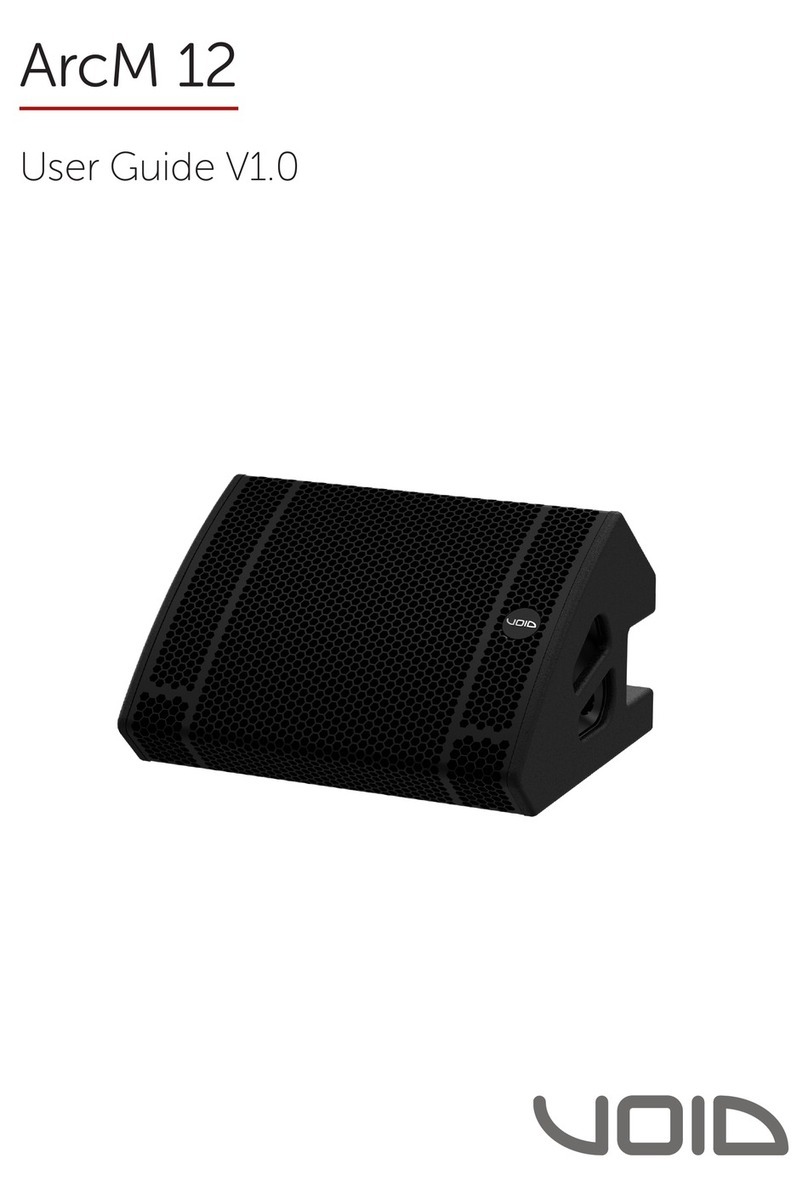
Void
Void ArcM 12 User manual

Void
Void Venu 208i User manual

Void
Void AXSYS 12 User manual
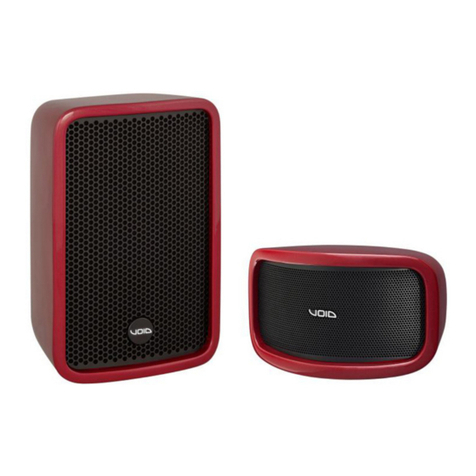
Void
Void Cyclone Series User manual
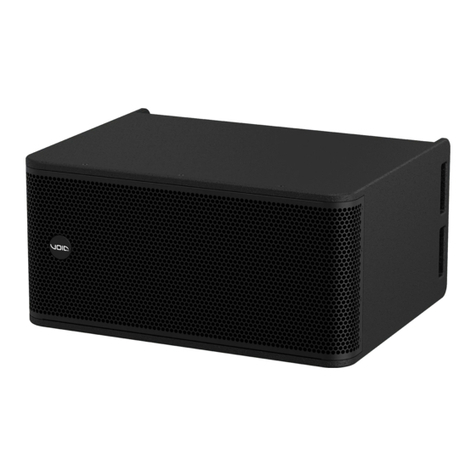
Void
Void Venu 210i V2 User manual

Void
Void Air Vantage User manual

Void
Void AIRTEN User manual
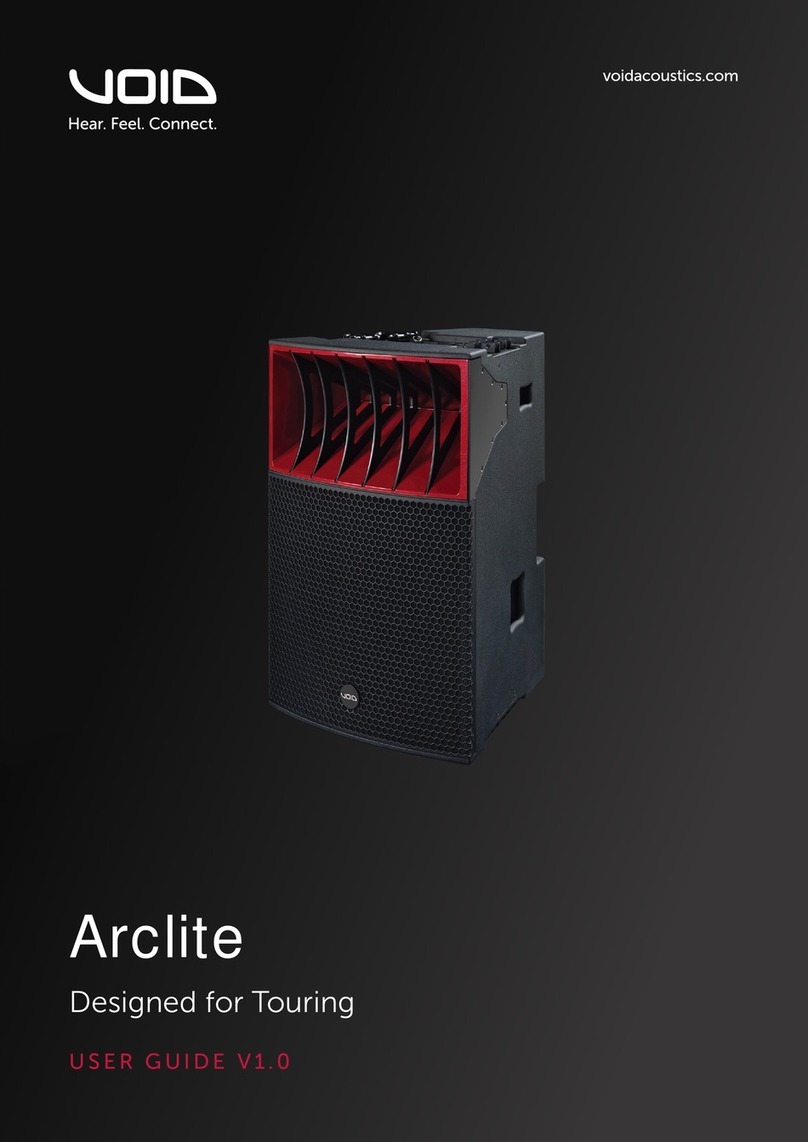
Void
Void Arcline Series User manual

Void
Void Cyclone 10 User manual

Void
Void Cyclone Bass User manual
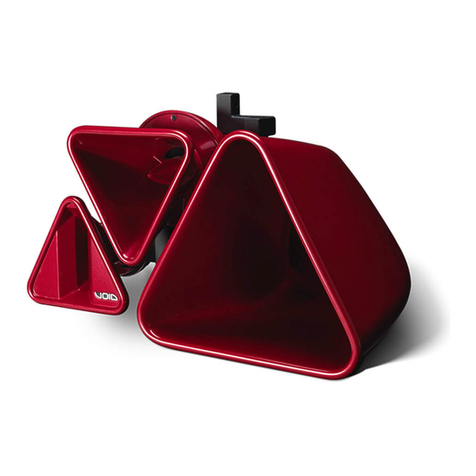
Void
Void Tri Motion User manual

Void
Void Air Vantage User manual

Void
Void AIRTEN User manual

Void
Void Cyclone 4 User manual

Void
Void Venu 6 User manual

Void
Void Indigo 6s User manual

Void
Void Sub Vantage User manual

Void
Void Venu 210i User manual
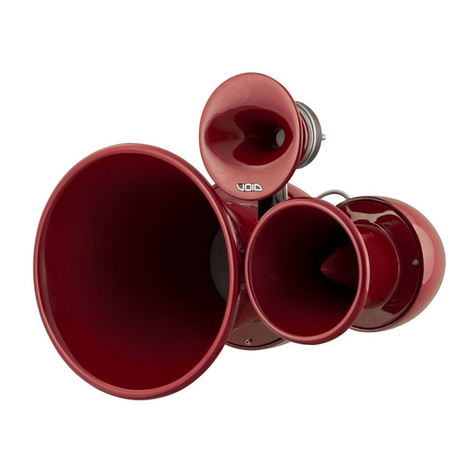
Void
Void Air Motion User manual

